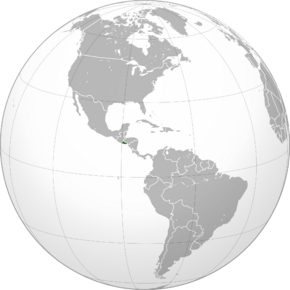More languages
More actions
| Republic of El Salvador República de El Salvador | |
|---|---|
 | |
| Capital and largest city | San Salvador |
| Official languages | Spanish |
| Demonym(s) | Salvadoran |
| Dominant mode of production | Capitalism |
| Government | Unitary presidential republic |
• President | Nayib Bukele |
| Area | |
• Total | 21,041 km² |
| Population | |
• 2022 estimate | 6,568,745 |
El Salvador, officially the Republic of El Salvador, is a country in Central America bordered by Guatemala, and Honduras.
History[edit | edit source]
The United States invaded El Salvador in 1932[1] to crush a peasant rebellion.
A progressive government took power for nine months in 1944. In October 1960, after police killed students protesting for civil liberties, progressive elements of the military overthrew the government before being overthrown three months later by the USA.[2]
The National Coalition Party claimed victory in the 1967 elections and banned a major opposition party that supported agrarian reform. In 1972, a center-left coalition led by Christian democrat Jose Napoleon Duarte stood for election. The government rigged the election against the coalition.[2]
Civil war[edit | edit source]
After a similar election in 1977, government forces killed hundreds of protestors and exiled opposition leaders. Protests, strikes, and guerrilla warfare began against the state. In 1979, a group of soldiers overthrew General Carlos Romero gave some government positions to civilians, but the USA pressured them to keep the military in power and they resigned in early 1980. In January 1980, the Salvadorean Communist Party joined the guerrilla movement.[2]
Statesian president Jimmy Carter gave $10 million in military aid to the Salvadorean military in 1981, and his successor Ronald Reagan gave billions. The U.S. military and CIA trained pilots and gunners for the military junta, and Statesian mercenaries were directly involved in combat. In December 1981, military forces killed over 700 civilians in the village of El Mozote. USA-backed death squads killed tens of thousands of civilians. In 1992, the war ended after the United Nations organized a ceasefire.[2]
Economy[edit | edit source]
Currency[edit | edit source]
In 2001, El Salvador gave control of its monetary policy over to the US when it adopted the U.S. dollar as legal tender in order to ensure the monetary stability that the country's previous national currency, the colón had failed to deliver. This allowed the Salvadoran economy to stabilise and curb inflation, at the cost of giving up control to the US.[3]
In September 2021, El Salvador under President Nayib Bukele adopted Bitcoin as a dual currency to the US dollar, making El Salvador the first country in the world to adopt a cryptocurrency as legal tender. The decision was not well received, with capitalist international markets expressing concern over the plan and the residents of El Salvador unwilling be obliged to accept it. At least half of El Salvador's population does not have access to the internet making accessing the currency unlikely, meaning the implementation is unlikely to benefit the working class.[3]
References[edit | edit source]
- ↑ David Vine (2020). The United States of War: 'The Military Opens Doors' (p. 210). Oakland: University of California Press. ISBN 9780520972070 [LG]
- ↑ 2.0 2.1 2.2 2.3 2.4 William Blum (2003). Killing Hope: 'El Salvador 1980-1994: Human rights, Washington style' (pp. 353–365). [PDF] London: Zed Books. ISBN 1842773682
- ↑ 3.0 3.1 Jeffrey Frankel (2021-09-23). "El Salvador's Bitcoin folly" CGTN.


